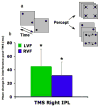The 'when' parietal pathway explored by lesion studies
- PMID: 18708141
- PMCID: PMC5076376
- DOI: 10.1016/j.conb.2008.08.004
The 'when' parietal pathway explored by lesion studies
Abstract
The perception of events in space and time is at the root of our interactions with the environment. The precision with which we perceive visual events in time enables us to act upon objects with great accuracy and the loss of such functions due to brain lesions can be catastrophic. We outline a visual timing mechanism that deals with the trajectory of an object's existence across time, a crucial function when keeping track of multiple objects that temporally overlap or occur sequentially. Recent evidence suggests these functions are served by an extended network of areas, which we call the 'when' pathway. Here we show that the when pathway is distinct from and interacts with the well-established 'where' and 'what' pathways.
Figures


Similar articles
-
Fast and slow parietal pathways mediate spatial attention.Nat Neurosci. 2004 Mar;7(3):217-8. doi: 10.1038/nn1203. Epub 2004 Feb 22. Nat Neurosci. 2004. PMID: 14983182
-
The 'when' pathway of the right parietal lobe.Trends Cogn Sci. 2007 May;11(5):204-10. doi: 10.1016/j.tics.2007.03.001. Epub 2007 Mar 26. Trends Cogn Sci. 2007. PMID: 17379569 Free PMC article.
-
Opposite biases in salience-based selection for the left and right posterior parietal cortex.Nat Neurosci. 2006 Jun;9(6):740-2. doi: 10.1038/nn1709. Epub 2006 May 14. Nat Neurosci. 2006. PMID: 16699505
-
Stages of self-motion processing in primate posterior parietal cortex.Int Rev Neurobiol. 2000;44:173-98. doi: 10.1016/s0074-7742(08)60742-4. Int Rev Neurobiol. 2000. PMID: 10605646 Review. No abstract available.
-
A parietofrontal network for spatial awareness in the right hemisphere of the human brain.Arch Neurol. 2006 Sep;63(9):1238-41. doi: 10.1001/archneur.63.9.1238. Arch Neurol. 2006. PMID: 16966500 Review. No abstract available.
Cited by
-
Time dilation caused by static images with implied motion.Exp Brain Res. 2012 Nov;223(2):311-9. doi: 10.1007/s00221-012-3259-5. Epub 2012 Sep 13. Exp Brain Res. 2012. PMID: 22972451
-
Schizotypal perceptual aberrations of time: correlation between score, behavior and brain activity.PLoS One. 2011 Jan 18;6(1):e16154. doi: 10.1371/journal.pone.0016154. PLoS One. 2011. PMID: 21267456 Free PMC article.
-
Detecting and representing predictable structure during auditory scene analysis.Elife. 2016 Sep 7;5:e19113. doi: 10.7554/eLife.19113. Elife. 2016. PMID: 27602577 Free PMC article.
-
Altered neural activity in the 'when' pathway during temporal processing in fragile X premutation carriers.Behav Brain Res. 2014 Mar 15;261:240-8. doi: 10.1016/j.bbr.2013.12.044. Epub 2014 Jan 5. Behav Brain Res. 2014. PMID: 24398265 Free PMC article.
-
Cerebral Substrates for Controlling Rhythmic Movements.Brain Sci. 2020 Aug 3;10(8):514. doi: 10.3390/brainsci10080514. Brain Sci. 2020. PMID: 32756401 Free PMC article. Review.
References
-
- Mauk MD, Buonomano DV. The neural basis of temporal processing. Annu Rev Neurosci. 2004;27:307–340. - PubMed
-
- Bueti D, Walsh V, Frith C, Rees G. Different brain circuits underlie motor and perceptual representations of temporal intervals. J Cogn Neurosci. 2008;20:204–214. - PubMed
-
- Walsh V. A theory of magnitude: common cortical metrics of time, space and quantity. Trends Cogn Sci. 2003;7:483–488. - PubMed
-
- Burr D, Tozzi A, Morrone MC. Neural mechanisms for timing visual events are spatially selective in real-world coordinates. Nat Neurosci. 2007;10:423–425. The authors report psychophysical data using an adaptation paradigm in which subjects were asked to adapt to a drifting grating and were subsequently tested on retinotopic or spatiotopic locations relative to the adapting stimulus location. They provide clear evidence that the timing of visual events in the milliseconds range is likely performed by neural mechanisms localized in spatiotopic coordinates. - PubMed
Publication types
MeSH terms
Grants and funding
LinkOut - more resources
Full Text Sources
Miscellaneous

